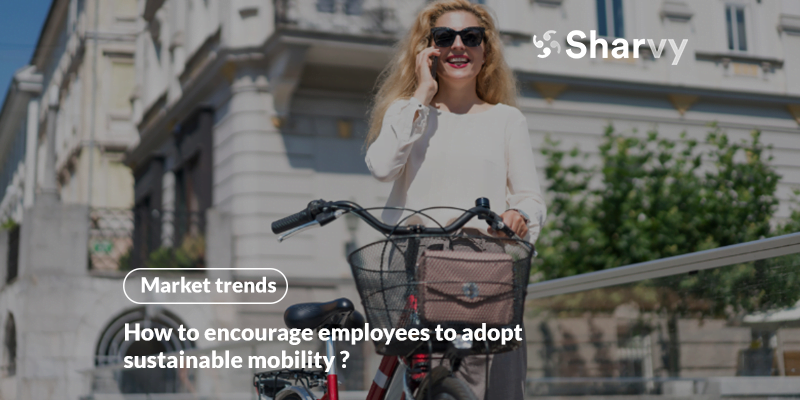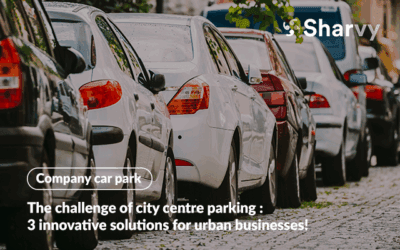Far from being anecdotal, the ecological concern is now a social issue.
For years, companies were only interested in making a profit and focused solely on their sales revenue and results. So, although economic performance is still essential to ensure the company’s sustainability, CSR is now a noble mission. It is necessary to remain competitive, attractive and maintain a certain legitimacy.
Nevertheless, the deployment of CSR policy still needs to be more active within companies. Practices are evolving, but (still) too slowly. The 2nd edition of the CSR Barometer (2022) of the Vendredi company bears witness to this. Indeed, 82% of companies say they need more time to accelerate their CSR policy. At the same time, 1 out of 3 companies also declare that they do not have the budget and/or the team allocated to it. Furthermore, more than one in three companies believe their employees could be more committed.
However, companies have a real card to play regarding sustainable mobility to raise awareness internally and get off to a good start regarding CSR. But how do you go about it? How do you encourage your employees to take an interest? What are the limits? The answers in this article!
A reminder : what is sustainable mobility in companies?
Many people tend to reduce sustainable mobility to a single definition. Namely : the need to satisfy the freedom of mobility while seeking to minimize the negative impact of transport on the environment. However, it must be borne in mind that mobility is only truly sustainable if it has an economic and social approach.
In urban areas, where agglomerations are densifying, the role of public transport, bike-sharing, and car-sharing becomes crucial. Cities like Paris and Lyon are expanding their bike lanes and strengthening their public transport services to improve access to peripheral and central areas, thus integrating effective intermodality between different modes of transport.
The social dimension is all the more important nowadays, as mobility is one of the essential pillars for individuals’ social and professional integration.
In companies, sustainable mobility means deploying more environmentally friendly transport solutions for employees without compromising their comfort and ease of travel.
For example, companies tend to reduce the intensity of business travel and only travel when necessary. Many are now using video conferencing to replace this travel. The change is hardly immutable for employees, which is a first step for the company in terms of CSR. So, although there is still a long way to go, awareness is growing, and actions are multiplying. This is why it is no longer possible for companies to put on blinders and/or turn a deaf ear! The time has come to act.
What are the employer’s obligations regarding sustainable mobility?
1. The mandatory provisions
Employers have a moral obligation to cooperate and promote wide-reaching sustainable transport solutions. For example, with initiatives like the UK’s Cycle to Work scheme, whereby the government subsidizes the cost of buying a bike for employees.
In addition, companies can decide to offer their employees mobility credits. Mobility Credits provide a cost-effective way of delivering targeted transport behavior change. For example, owners of the most polluting diesel vehicles (typically pre-Euro 5 diesel) are incentivized to scrap their cars in return for a ‘mobility credit’ that can be used to pay for a range of different public and private transport modes, including buses, trains, trams, bikes rental, car clubs, and car rental.
These mandatory provisions encourage companies and employees alike to adopt new habits and/or measures to improve the daily commute to work. According to the Department for Transport study conducted in 2019, 68% of Britons commute (still) to work by car.
2. The facultative provisions
Firstly, the optional provisions include the “Take a Stand program“. In the UK, the employer is not obligated to install a bicycle park in the company car park. However, to encourage the development of soft mobility in the country, it should be noted that many local authorities grant subsidies for the installation of equipment within the company car park that encourages the use of bicycles.
For example, in London, as part of the “Take a Stand” program set up by Transport For London, companies can obtain free bicycle racks, as well as funding for bicycle-related facilities (such as : bicycle anchoring equipment, covered & secure spaces, showers, and changing rooms). They can also purchase service bicycles at a negotiated price.
In addition, employers can benefit from the Workplace Charging Scheme (WCS). With the advent of electric and plug-in hybrid vehicles, the number of charging stations is increasing. As of June 2022, all new buildings in the UK and those undergoing major renovations with more than 10 parking spaces will be required to have a charging point. To support this approach, the WCS is offered by the Office for Zero Emission Vehicles (OZEV). This reduces the cost of purchasing and installing a charging point at the workplace by 75% (capped at £350 per socket). Please note that a single company can request a maximum of 40 outlets.
How can you encourage your employees to take an interest in sustainable mobility?
1. Simplify the use of soft mobility for daily journeys
By offering your employees “autonomous” modes of transport, such as bicycles, electric scooters, and NVEIs, you can reduce your company’s carbon footprint sustainably.
At the same time, and beyond the ecological aspect, you also enhance your employer brand and improve the attractiveness of your company. This is why taking the initiative and achieving a win-win model is important since the impact is positive for the environment and employees’ Quality of Life and Working Conditions (QLWC).
Consequently, there are many solutions to facilitate the use of soft mobility, including :
- The installation of a secure bicycle park in the company car park.
- The installation of shared charging points in your car park.
- The provision of showers on the company premises (or by reservation).
- Providing a room with several tools (reservation and service).
- Financial participation in season tickets (train, tram, metro, bus, etc).
- Setting up a fleet of company bicycles.
- Improving pedestrian access to the premises (creating paths, etc).
- Raising employee awareness of soft modes of transport and eco-driving.
- Using smart parking to facilitate the transition to sustainable mobility!
✔ Good to know : not only does cycling remain one of the most environmentally friendly modes of transport, but it is also one of the least expensive. According to ADEME, 10km per day by bike is equivalent to spending $100 per year – vs. $1000 by car over the same distance!
2. Encourage carpooling within your company for home-to-work journeys
Carpooling is a practice that is becoming more and more widespread within companies.
It allows your employees to share a common journey in the same vehicle. For example, to get to the company’s headquarters or a customer-supplier meeting.
To encourage company carpooling, think about making internal communication and/or creating an internal group : Teams, Slack, or WhatsApp (it doesn’t matter which platform) to connect employees open to carpooling. You can also use an external carpooling application (such as Karos or Blablacar, etc).
At the same time, it is interesting to establish preferential rules for access to the company car park, for example, by guaranteeing a space for carpoolers. Doing this encourages your employees to change their behavior in the long term! In addition, and especially if your company car park is busy, you can reduce the required parking spaces. In correlation, you improve its management and offer more employees access to the car park.
On this point, the Sharvy application can help you! It allows you to transform the passive management of your car park into intelligent and active management. As a result, your company car park becomes a common asset to be managed collaboratively. Note also that Sharvy has a common interface with Karos. Thus, motorists now conclude their carpooling in the Karos application. Then, a parking space of the company is automatically reserved for them in the Sharvy application.
3. Facilitate teleworking within your company
Like carpooling, teleworking reduces the number of vehicles on the road and thus relieves traffic congestion at peak times. However, this is a far from neutral observation when we know the impact of our home-work journeys on the environment, both in terms of greenhouse gas emissions and air quality!
According to a study conducted by ADEME, working people in employment are responsible for 56% of all journeys (all modes combined). The generalization of hybrid work, including (on average) 18% of working people, would make it possible to avoid 3.3 million journeys per day, or 42.9 million km, on a weekday.
A direct benefit for the environment, with a reduction in our CO2 emissions of around 3,300 tonnes at peak times on a weekday, according to the study’s low hypothesis.
Given this, how can we not want to facilitate the implementation of telework? To do this, think about :
- Lend your employees adequate equipment (computer, smartphone, headset, etc).
- Installing video and/or telephone conferencing tools.
- Providing employees with several workspaces (corpoworking, coworking, etc).
- Adjust your employees’ working hours!
✔ Good to know : modifying the employment contract to allow an employee to telework is no longer necessary. It can now be implemented more easily. For example, with a simple agreement between the employer and the employee, with a collective agreement, or with a charter drawn up by the employer after consulting the CSE.
4. Improve the parking experience!
The time required to find a parking space represents as much lost time as pollution emitted by the vehicle. It is, therefore, essential to rethink how parking is used to reconcile the need to free up space with the parking needs of the user.
For this reason, many companies decide to improve their parking experience using a digital solution like Sharvy.
With the Sharvy application, employees can plan their mobility. Before their arrival on site, they request to reserve a parking space. After that, the fair algorithm automatically distributes the available spaces according to the priority rules defined by the administrator.
So you might think that parking encourages people to take the car, but it is an opening towards developing other forms of mobility. In this sense, you encourage the rotation of parking spaces, which leads to less reluctance on the holder’s part to use public transport and/or to favor soft mobility. The holder can also free up their space for the day via the application. And this, without losing the use of his parking space, promotes multimodality.
✔ Good to know : by digitizing the management of your car park, you can collect, interpret and follow the evolution of numerous data (car park occupancy statistics, activity history), which will allow you to make the right decisions regarding its management, and to boost and improve the parking experience for users. To help you, download our free e-book!
5. Replace (gradually) your fleet of thermal vehicles with electric models!
Many companies have a fleet of vehicles (company cars, vans, and/or two-wheelers) for their employees.
Gradually replace your fleet with electric vehicles to take another step towards sustainable mobility.
In addition, consider that you can benefit from the Workplace Charging Scheme (WCS) offered by the Office for Zero Emission Vehicles (OZEV). By installing shared charging points in your company car park, you enable your employees who want to drive to work in their electric car not to worry about charging it, while promoting electric mobility. In this way, you are actively encouraging environmentally-friendly behaviour among employees, customers and/or suppliers who have not yet gone green.
✔ Good to know : installing charging points within your car park will also allow you to develop your company’s visibility, and why not attract new customers? Not least because new applications, such as Zapmap and Open Charge Map, allow electric vehicle drivers to plan their routes and find sites with electric charging points.
6. Create fun & motivating internal challenges!
If you want to encourage your employees to use alternatives to the private car to get to your workplace, consider internal challenges!
For example, there is the Ma Petite Planète (MPP) challenge. This offers some ecological challenges to be carried out in teams over three weeks. It allows your employees to increase their skills in various subjects related to the environment and, in correlation, to sustainable mobility. It also allows you to identify areas for eco-responsible improvement within your company.
Beyond being fun and motivating, these challenges aim to push your employees to take action! This way, you rely on the levers of competition and emulation between colleagues to create new (sustainable) mobility habits.
✔ Good to know : before the event, think of setting up an attractive communication to push your teams to give their best to win! For example, send a teaser before the event starts, organize a question and answer session, and remind them of the prizes at stake. And above all, don’t forget to set up a weekly newsletter to share the progress.
In conclusion
As an employer, many solutions are available to you to organize and improve your employees’ mobility. Take up this challenge as you see fit, depending on your business model, constraints, and budget.
Whatever the case, and whatever your level of involvement, you will contribute to positively impacting your entire ecosystem, i.e., your city (with better traffic flow and a CO2 reduction) – your employees (with varied, ecological transport solutions that can be customized according to their lifestyles) and your company (with improved working conditions, greater attractiveness for recruiting talent, etc.). These are not insignificant points these days!
Have a question? Check the following FAQ!
Why promote sustainable mobility in your company?
There are many advantages, both for the company and for the employees.
For the company, it allows it to :
- Enhance the company’s image and attract new talent sensitive to CSR.
- Strengthen social links between employees (carpooling, car sharing, etc).
- Develop the company culture and team spirit through a shared commitment.
- Enhance the value of your commitments by (possibly) gaining legitimacy with labels!
- Improve the management of their company car park and optimize the budget dedicated to this item.
On the employees’ side, it allows them to :
- Reduce the daily stress of commuting.
- Obtain a space in the company car park (if carpooling, car sharing, etc).
- Optimise the time spent traveling to work.
- To have a wider choice of travel modes.
- To commit (at their level) to protecting the environment.
What are the environmental benefits of sustainable mobility in companies?
When a company and its employees harmonize their actions to achieve more sustainable mobility during commuting, the benefits for the planet are various :
- A reduction in energy demand
- Better air quality through the use of healthier transport.
- A possible gain in public space (less parking on the public highway).
- Reducing negative externalities linked to transport (CO2 emissions, noise pollution, traffic jams, etc.).
Are sustainable mobility policies suitable for all companies, whatever their size?
Yes, sustainable mobility policies are suitable for all companies, whatever their size. The fundamental principle of sustainable mobility is the promotion of environmentally friendly modes of transport, a consideration that transcends the company’s size.
For large companies, implementing sustainable mobility policies can lead to significant benefits in terms of reducing greenhouse gas emissions, managing vehicle fleets more efficiently, and improving brand image through a concrete commitment to environmental responsibility.
Similarly, small and medium-sized businesses can benefit from these policies by making substantial savings on travel-related costs, meeting increasing regulatory requirements in terms of carbon footprint, and creating a working environment that attracts and retains environmentally aware talent.
What are the most common sustainable mobility options adopted by companies?
In most cases, companies find it easier to adopt sustainable mobility policies that include car-sharing, cycling, public transport, teleworking, electric vehicles and soft mobility policies that encourage walking.
Want to learn more? Check out our latest articles!
Flex office & its disadvantages : what you need to know before adopting it!
What is the flex office? How does it work? What are its drawbacks and how can you overcome them? Find the answers in this article!
Optimise your company car park during the holidays : tips & tricks!
How can you reinvent your company car park management during the holidays? What solutions and tips can you come up with? Focus!
The challenge of city centre parking : 3 innovative solutions for urban businesses!
Urban businesses : what solutions can be found to meet the challenge of city centre parking? Our advice and tips in this article!
Subscribe to our newsletter!
Resources
Contact us
+44 117 463 6990







